The Land Of China -- Explore by Province
Guangdong
Guangdong is located in south China and faces Hainan across the strait. Half of the province has subtropical weather. It is the provincial home of many Chinese immigrants who
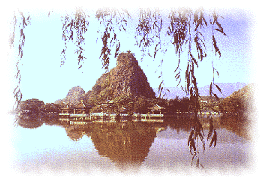 Guangdong
Guangdong
|
brought back expertise and money to their ancestral home and contains the largest number of overseas Chinese. Shantou, Meixian, and Guangzhou are famous hometowns for overseas Chinese people.
Since China carried out the "Open Door" policy, Guangdong has been a pioneer in reforming the Chinese economy. Open economic areas extend along its entire coast and parts of its interior. An all-round development has taken place in the field of finance, commerce, foreign trade, industry, and agriculture. In many respects, Guangdong tops other provinces in the country. The province has countless small and medium-sized enterprises as well as many famous large firms. It is also rich in fruits, vegetables and livestock.
Guangzhou is one of China's most famous ancient cultural cities and is the largest metropolis and foreign trade port in southern China. It is located in the climatic subtopical zone with an annual average temperature of 22° C and an annual average rainfall of 1,700 mm. Flowers blossom all year round, making Guangzhou known as a "City of Flowers." The city has long been renowned for its Fuangdong cuisine and local snacks. The city is 125 kilometers northwest of Hong Kong on the Pearl River and is the end of the Beijing-Guangzhou Railway. Baiyun Airport has regular flights to metropolises within and outside the province, as well as to Hong Kong and Southeast Asian countries. Passenger and cargo ships shuttle between Guangzhou and large and medium-sized cities in China and other parts of the world via the Huangpu and Guangzhou ports.
Guangzhou was the seat of the Prefecture of Nanhai in 214 B.C. It was the site of many important historical events in China's modern history. In 1983, a 2100-year-old imperial tomb was discovered where more than 1000 burial objects were excavated, among which are a chariot, gold and silver vessels, musical instruments, and human sacrifices. The site is now the Museum of the Western Han Dynasty Mausoleum of the Nanyue King. In Yuexiu Park, you can find sculptures of six goats, the symbol of Guangzhou. The South China Botanical Garden is one of the world's largest, containing over 2000 species of tropical and subtropical plants. The Orchid Garden is also a delight for orchid lovers with almost 10,000 plants.
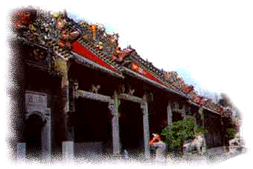 the Chen Family Temple
the Chen Family Temple
|
The Chen Clan Academy is housed in a large compound built between 1890 and 1894. It is said to have been founded by the Chen Clan from 72 different counties throughout Guangdong, for they donated a fund and built the compound. The academy, with an area of ten thousand square meters, looks magnificent. The construction is decorated with wood carvings, porcelain sculptures, stone carvings, and iron cast that display ancient stories, fairy tales, and beautiful scenery. Today, the Academy has been renamed as the Guangdong Folk Handicraft Museum.
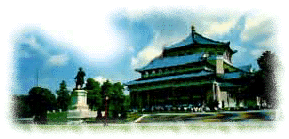 the Dr. Sun Yat-sen Memorial Hall
the Dr. Sun Yat-sen Memorial Hall
|
The Dr. Sun Yat-sen Memorial Hall was built in honor of Dr. Sun Yat-sen with a donation from overseas Chinese and Guangzhou citizens. Construction began in 1929 and finished in 1931. The hall stands on the site of the government building when Dr. Sun Yat-sen was President. The building is octagonal in shape, with an area of 12,000 square meters and a height of 47 meters. The hall now serves as a meeting hall with a seating capacity of 4,700. In front of the hall stands a bronze statue of Dr. Sun Yat-sen.
The Guangxiao Temple (the Bright Filial Piety Temple) has a history of 1,500 years, with an area of 30,000 square meters. It is the oldest temple in Guangdong and used to be the residence of Zhao Jiande - the great-grandson of the Southern Yue King in the third century. The temple came about during the period of the Tang and Song Dynasties. It is particularly significant it is the temple where the famous Monk, Hui Neng, was initiated into monkhood.
 the National Tourism Resort of Nanhu Lake
the National Tourism Resort of Nanhu Lake
|
The National Tourism Resort of Nanhu Lake in Guangzhou is located on the northeastern outskirts of Guangzhou. The Recreation Center of the resort launches two recreation items. One is a laser field operation, in which people can experience a virtual "real" battle. The other is a water parachute, which is unique and exciting. The Medical Care Center invites outstanding specialists to provide domestically first-class services. The Golf Country Club lying at the foot of Mt. Baiyun, finished in 1996, is an 18-hole course.
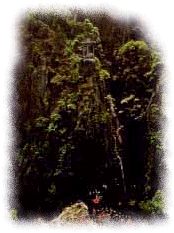 Xiquiao Hills
Xiquiao Hills
|
About 60 kilometers southwest of Guangzhou is another scenic spot - Xiquiao Hills. The area has 72 peaks, 36 caves, springs, and waterfalls. The hills are generally not very high, but they are famous for their beautiful scenery.
Half way up the western hill is the famous Baiyun, or White Cloud, Cave. It is a cave with splendid views. The legend goes that a famous scholar named He Baiyun from the Ming Dynasty used to study in this place. Therefore, the cave was named after him. Outside the cave are pine trees , which surround a number of old architectures - houses, pavilions, and a temple. It is definitely a nice summer resort.
About 110 kilometers west of Guangzhou is Zhaoqing, famous for its scenery and Duan inkstones. The Seven Star Crags have caves with grotesque limestone formations and an underground stream for boat riding. The Dinghu Lake is a lake formed on a volcano mouth. At the foot of the valcano is a natural forest reserve.
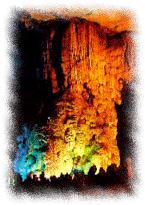 the Seven-Star Cave
the Seven-Star Cave
|
The Seven-Star Cave, formerly called Xixia (Sun's Resting) Cave, lies on the western shoulder of Putuo Hill. The cave, originally an underground river, was formed by crust changes that raised the level of the river bed. The cave has three layers. The middle layer has an 800-meter long tourist route, which is 43 meters wide at its widest point and 27 meters high at its highest. The lower layer is an underground river. The stalactites and stalagmites in the cave are translucent, as white as snow, and as fine as jade, giving the cave an enchanting beauty. The Jade Rabbit, Golden Lion, Silver Snake, Pandas Gamboling over the Snowball, and other scenes in the cave all have such a lifelike quality that the cave has been called An Abode of the Immortals. The cave has been a favorite tourist spot ever since the Sui and Tang Dynasties over a thousand years ago. In and out of the cave are also many ancient inscriptions and poems in praise of the cave.
 Dinghu Mountain
Dinghu Mountain
|
Eighteen kilometers east of Zhaoqing, Dinghu Mountain is famous for the pool on the top of its peak. The legend goes that Huang Di built a tripod on the mountain. Scenic spots include streams, brooks, pools, hills, and pavilions. On the mountain grows more than 1,700 varieties of plants. The mountain has been designated as a research center of the UN Man and Biological Circle project.
Splendid China in Shenzhen is the largest miniature collection of China's famous scenic places, including Beijing's Forbidden City and the Great Wall, Tibet's Potala Palace, the Terra Cotta Warriors in Xi'an, and many other famous places. Every structure is built at a proportion of one-tenth or one-fifteenth of its life size. Splendid China will give visitors an idea of China's best-known sights.
Built in the western suburbs of Shenzhen, Window on the World covers an area of 48,000 square meters. It is a collection of miniature buildings resembling the worlds most famous places, such as the Pyramid in Egypt, the Grand Canyon, the Opera House in Sydney, the Taj Mahal in India, and many other famous architectures of the world. The park consists of the World Square, Asian Section, Pacific Section, African Section, European Section, and American Section. It is a place for those who have never been to such places to have a quick preview and visit to the most famous sights of the world.
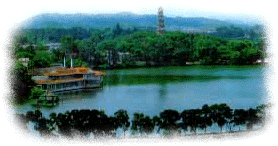 West Lake
West Lake
|
West Lake, with a surface area of 1.69 square kilometers, is located in Huizhou. The lake became famous because of the well-known Song Dynasty scholar Su Dongpo who once resided here after he was deprived of his post in court. When he lived here, he contributed funds to build bridges and pavilions, which were carved with his poems. Even now in the area around the lake are scenic spots named after him.
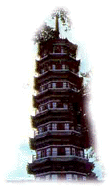 the Temple of the Six Banyan Trees
the Temple of the Six Banyan Trees
|
The Temple of the Six Banyan Trees was built during the 6th century and was ruined by fire in the 10th century. At the end of the 10th century the temple was rebuilt. The name Six Banyan Trees was given by Su Dongpo, a celebrated poet and calligrapher of the Northern Song Dynasty who often visited the temple and wrote poems. Within the temple there is an octagonal pagoda called the Flower Pagoda that is 57.6 meters tall, the tallest old architecture in the area. The pagoda, when seen from the outside, looks like it has nine stories; yet in actuality it has 17. The temple houses three huge bronze Buddhist statues made in 1663, each of which is 6 meters high and weighs 10 tons. They are the largest old bronze statues in Guangdong.
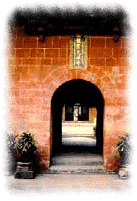 the Huaisheng Mosque
the Huaisheng Mosque
|
The Huaisheng Mosque, also known as the Guangta Mosque or the Smooth Tower Mosque, is one of the earliest mosques established after Islam was introduced into China in the 7th century. The original mosque on this site is said to have been set up in 627 A.D. by the first Muslim missionary, an uncle of Mohammed. Huaisheng means "Remember the Sage" in memory of the prophet. Inside the mosque is a minaret, which is 36 meters tall with a pointed tower. It is a typical Arabic architectural style. This minaret is known as Guangta - Smooth Tower.
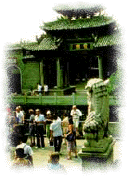 the Ancestors' Temple
the Ancestors' Temple
|
The Ancestors' Temple, a Taoist temple, is the number one tourist attraction in Foshan. Construction of the temple began during the reign of emperor Shen Zong of the Song Dynasty (1078-1085). The temple was burnt down at the end of the Yuan Dynasty in the mid-1300s, but was rebuilt at the beginning of the Ming Dynasty during the reign of the first Ming Emperor, Hong Wu. The temple covers an area of 3,000 square meters, with the Front Hall, the Main Hall, the Rear Hall, the Jinxiang Pool, and the Wanfu Terrace. The structure of the temple is entirely made of wooden beams, without nails or any other material. It is roofed with colorful tiles and decorated with images of people, flowers, and birds and animals. The walls are also carved in various patterns.
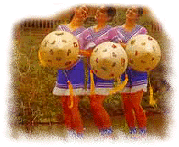 the China Folk Culture Villages
the China Folk Culture Villages
|
The China Folk Culture Villages, situated near Shenzhen Bay, is adjacent to Splendid China. It was built and opened to the public in 1991. The whole area includes 24 villages of 21 different nationalities. Each village will give visitors demonstrations of the life of different nationalities. Buildings in this place are built life-size, including temples, bridges, and houses built in different ethnic styles. Visitors can, within one day, have an overall view of the life and customs of different nationalities. Meanwhile they can also enjoy a taste of various food and dishes.




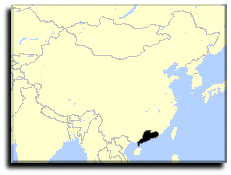
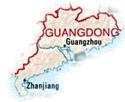
















 Chinese Culture
Chinese Culture